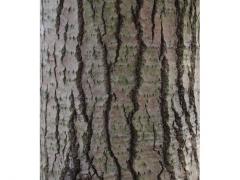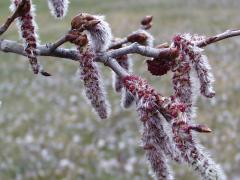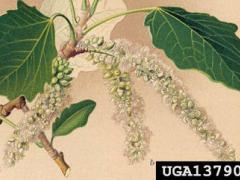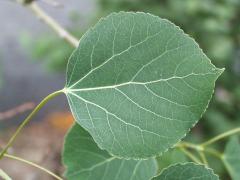Invasive Species: Populus alba, White Poplar
White poplar is an invasive tree that can grow 40 to 80 ft. (12.2 to 24.4 m) tall and 40 to 50 ft. (12.2 to 15.2 m) wide. The bark on young trees is smooth and greenish white, becoming gray and wrinkled as trees age. The leaves resemble maple leaves, but the topside of leaves is shiny, dark green while the underside is bright white and hairy. Leaves are 2 to 4 in. (5.1 to 10.2 cm) long. Flowers are inconspicuous and develop in slim, cylindrical flower clusters (catkins) before the leaves develop. Fruit are small, hairy seed pods that are spread by wind. Branches are susceptible to breakage when under stress, such as heavy snow or ice. Trees produce prolific root sprouts. White poplar is native to Eurasia and grows best in full sun.
What are invasive species and why should we be concerned about them?
Taxonomy: Scientific and Common Names for This Species
Salicales > Salicaceae > Populus alba L.
Synonym(s): none
Populus alba – USDA PLANTS Profile
Distribution Maps
White poplar – The reported distribution of this invasive species across the United States. (Source: Invasive Plant Atlas of the United States)
Up-to-the-minute distribution maps and why they are important
Reporting This Invasive Species
What is the best way and place to report the occurrence of an invasive species?
How to report an invasive species sighting to EDDMapS – Early Detection & Distribution Mapping System
EDDMapS – Report an invasive species to EDDMapS
Cooperative Extension Offices – Find your local Cooperative Extension office on this map provided by USDA
How to Identify
This invasive species can be identified by looking for the characteristics described in the paragraphs that follow.
Tree
An invasive tree that can grow 40 to 80 ft. (12.2 to 24.4 m) tall and 40 to 50 ft. (12.2 to 15.2 m) wide. The bark on young trees is smooth and greenish white, becoming gray and wrinkled as trees age.
|
|
 |
| Leslie J. Mehrhoff, University of Connecticut, bugwood.org | Leslie J. Mehrhoff, University of Connecticut, bugwood.org |
Foliage
The leaves resemble maple leaves, but the topside of leaves is shiny, dark green while the underside is bright white and hairy. Leaves are 2 to 4 in. (5.1 to 10.2 cm) long.
 |
 |
| Leslie J. Mehrhoff, University of Connecticut, bugwood.org | Wendy VanDyk Evans, bugwood.org |
Flower
Flowers are inconspicuous and develop in slim, cylindrical flower clusters (catkins) before the leaves develop.
 |
 |
| Leslie J. Mehrhoff, University of Connecticut, bugwood.org | Paul Wray, Iowa State University, bugwood.org |
Fruit
Fruit are small, hairy seed pods that are spread by wind.
 |
 |
| Zelimir Borzan , University of Zagreb, bugwood.org |
Franklin Bonner, USFS (ret.), bugwood.org |
Native Species That Resemble White Poplar
Populus deltoides, eastern cottonwood – Images at invasive.org
Populus tremuloides, quaking aspen – Images at invasive.org
 |
 |
| Paul Wray, Iowa State University, bugwood.org | Paul Wray, Iowa State University, bugwood.org |
Additional Images for White Poplar
White poplar – Images at Invasive.org
Learning Resources for White Poplar
Populus alba – University of Florida
White Poplar – Virginia Tech
Additional Information, Biology, Control and Management Resources
Control and management recommendations vary according to individual circumstances. Location, habitat, weather, and a variety of other conditions are factors that help determine the best treatment choice. To find the safest and most effective treatment for your situation, consult your state’s land-grant institution. If you will use chemicals as part of the control process, always refer to the product label.
United States Land-Grant University System – Find your land-grant university’s College of Agriculture, Cooperative Extension Service, or other related partner on this map provided by USDA.
Weeds Gone Wild: Alien Plant Invaders of Natural Areas – Plant Conservation Alliance
Weed of the Week – USDA Forest Service
Invasive Plant Atlas of New England – University of Connecticut
Populus alba – UConn Plant Database
Populus alba – FloriData
Jepson Herbarium – University of California

